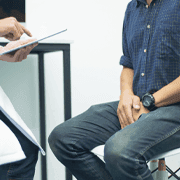Left Kidney Pain: Causes, Symptoms, And Treatments
In This Article
Left Kidney Pain: Causes, Symptoms, And Treatments
Jaymala
Updated on January 15, 2024
Medically verified by Dr. Arya
Fact checked by Dr. Pournami

Urology
4 min read
Mykare Health is here to break down the common causes, symptoms, and available treatments to navigate and manage left kidney pain.
Let’s get to the basics and resolve your queries!
How are Kidneys Important To Us?
Let's have a look:
The kidneys are important organs in the human body with a v of essential functions which contribute to maintaining overall health. Positioned on either side of the spine, these bean-shaped organs play an important role in the urinary system.
What Are Their Functions?
- Filtration of Blood
- Regulation of Fluid and Electrolyte Balance
- Acid-Base Balance
- Blood Pressure Regulation
Importance of Recognising a Left Kidney Pain
- Recognising left kidney pain is often the first step in identifying underlying health issues such as kidney stones, infections, or trauma.
- Left kidney pain, if left untreated, can lead to complications such as kidney damage
- Once left kidney pain is identified, healthcare providers can initiate timely investigations and other tests.
Causes of Left Kidney Pain
Wondering what causes left kidney pain? Here they are:
- Formation of hard deposits( kidney stones) in the kidneys causes severe pain as stones move through the urinary tract.
- Bacterial infection affecting the urinary tract, including the kidneys can cause pain.
- Injury to the left kidney due to accidents, falls, or blunt force trauma.
Symptoms of Left Kidney Pain
How would you identify left kidney pain? Here are some common signs.
- Dull, aching, or sharp pain on one side of the lower back or flank.
- Discomfort or pain while urinating may accompany kidney issues, such as infections or stones.
- Increased frequency of urination, may be a symptom of urinary tract infection or kidney problems.
- Visible blood in the urine or urine that appears pink, red, or brown.
- Changes in urine colour and odour.
 6 min read
6 min readWhat is Stapler Circumcision - Everything You Need to Know
 8 min read
8 min readIs Circumcision Good or Bad - Here's How to Find Out
 8 min read
8 min readCircumcision - Scientific Guide to All Your Questions
Get a Callback Now
Diagnosing Left Kidney Pain
Diagnosing left kidney pain involves a comprehensive evaluation that includes a combination of medical history, physical examination, and diagnostic tests.
- The healthcare provider will gather information about the patient's medical history.
- The healthcare provider will conduct a physical examination.
- Urinalysis: This test examines the urine for the presence of blood, protein, white blood cells, and other substances.
- Complete Blood Count (CBC) can help identify signs of infection or anaemia, which may be associated with kidney issues
Imaging Studies
- Imaging studies are important tools in diagnosing and evaluating the causes of left kidney pain as follows:
- Ultrasound: Detects kidney stones, cysts, tumors, and abnormalities in the kidney.
- CT Scan (Computed Tomography): Provides high-resolution images, useful for identifying kidney stones, tumors, infections, and structural abnormalities
- MRI (Magnetic Resonance Imaging): Especially valuable for assessing soft tissues, blood vessels, and distinguishing between different types of kidney tissues.
Treatment Approaches
The treatment of left kidney pain depends on the cause identified through a thorough diagnosis.
- Over-the-counter pain relievers, such as acetaminophen or nonsteroidal anti-inflammatory drugs (NSAIDs), can help alleviate mild to moderate pain.
- Encouraging increased fluid intake to help flush out stones.
- Medical Expulsion Therapy: Medications to facilitate the passage of stones.
- Shock wave lithotripsy, ureteroscopy, or surgical removal for larger stones.
- Antibiotics may be prescribed to treat bacterial infections.
- Severe injuries may require surgery.
Preventing Left Kidney Pain
- Drink an adequate amount of water throughout the day to promote proper kidney function.
- Limit sodium intake to maintain blood pressure and reduce the risk of kidney issues.
- Consume a balanced diet rich in fruits, vegetables, and whole grains.
- Engage in regular physical activity to promote overall health .
When to Seek Medical Attention?
When should you really need to visit a doctor?
- Severe or Persistent Pain
- Fever and Chills
- Blood in Urine
- Difficulty Urinating
- Nausea and Vomiting
- Trauma or Injury
- Difficulty Breathing or Chest Pain
Left kidney pain can have various causes, including kidney stones, urinary tract infections, kidney infections, and other kidney-related conditions.
Symptoms of left kidney pain may include pain during urination, frequent urination, blood in urine.
Diagnosing left kidney pain involves a thorough medical history, physical examination, and various tests.
Imaging studies play a crucial role in identifying underlying issues, including kidney stones, infections, or any other causes.
Treatment approaches depend on the specific cause of left kidney pain.
Preventing left kidney pain involves staying hydrated, maintaining a healthy diet, regular exercise, limiting alcohol and caffeine and maintaining a healthy lifestyle.
Seek medical attention promptly if you experience severe or persistent pain.



